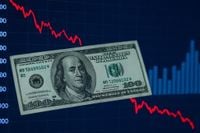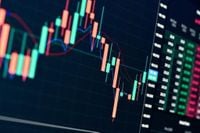In a surprising turn of events, the U.S. dollar fell sharply following the announcement of new tariffs by President Donald Trump on April 2, 2025. This decline occurred despite an increase in the Cboe Volatility Index (VIX) and rising Treasury yields, which typically signal a flight to safety and an appreciation of the dollar. Steven Kamin, a former head of international finance at the Federal Reserve, noted that this unusual behavior suggests deeper concerns among investors about the U.S. economic policy landscape.
Kamin explained that during previous crises, such as the COVID-19 pandemic, the dollar and the VIX rose concurrently. However, this time, "the dollar has not benefited from the flow into safe assets," indicating a significant shift in market dynamics. He pointed out that the current situation represents the largest deviation from predictive models in the past four years, with the dollar's actual performance diverging dramatically from what was anticipated based on historical trends.
During the March 2020 crisis, for instance, demand for Treasury bonds surged, leading to falling yields. In stark contrast, after Trump's recent tariff announcements, yields have risen while the dollar has fallen. Kamin remarked that this selling driven by deleveraging is uncommon and reflects structural doubts about U.S. economic policy. He, along with Mark Sobel, has previously warned that the dollar's dominance is contingent on fundamental factors like adherence to the rule of law, sound economic policies, and international cooperation. "If the U.S. abandons these strengths, other countries will seek alternatives," they cautioned.
Despite not forecasting an immediate end to the dollar's supremacy, the current episode suggests a symbolic weakening, with concerns mounting over the future trajectory of the U.S. economy amid escalating tariff tensions and aggressive fiscal policies.
On a more optimistic note, the stock market is showing signs of recovery after a tumultuous period. A buy signal flashed on April 14, 2025, suggesting that the stock market may have reached its bottom, according to Tom Lee, head of research at Fundstrat. The S&P 500 had briefly dipped into bear-market territory before rallying 10% in a single session, although it remains 12% below its record highs.
Lee is closely monitoring the VIX, which he considers a reliable indicator of market sentiment. He noted that when the VIX rises above 60 and then falls below 31, it typically signals a market bottom. Recently, the VIX closed at 30.89 and continued to decline, suggesting that volatility may have peaked. Lee expressed confidence that if the VIX has indeed peaked, it would be an opportune time to buy stocks, projecting that the S&P 500 could rise to 5,500 before entering a new upward trend.
Adding to the positive sentiment, Treasury Secretary Scott Bessent indicated that market uncertainty has likely peaked, reinforcing Lee's outlook. Bessent's remarks came in an interview where he acknowledged the heightened volatility but suggested that the worst may be over.
Moreover, Trump's recent willingness to exempt certain consumer electronics manufactured in China from tariffs and his commitment to assist the auto sector in adapting to these tariffs hint at a potential easing of trade tensions. Lee interpreted these developments as indicative of "more voices in the room" regarding tariff policies, which could further bolster market confidence.
In the midst of these fluctuations, the VIX has seen unprecedented activity. Following Trump's tariff announcement, the VIX surged above 30 points, even exceeding 50 at its peak, levels not witnessed since the pandemic's peak in 2020. This volatility has significantly boosted the performance of products linked to the VIX, with the SG ETN VIX FUTURE emerging as the most profitable exchange-traded note (ETN) of 2025, boasting a remarkable rise of 71.24% year-to-date.
However, the SG ETN VIX FUTURE, which replicates the daily performance of a long position in VIX futures, has experienced a severe average annual decline of 43.54% over the past three years. This stark contrast highlights the inherent risks associated with such investments, particularly in a low-volatility environment.
Despite its short-term success, the SG ETN VIX FUTURE is primarily a tactical product, utilized by professional investors to hedge against volatility spikes rather than a long-term hold. With only 1.7 million euros in assets, it remains a niche product aimed at knowledgeable investors who understand its complexities and risks.
As the markets adjust to the current climate, Cboe has responded by launching 24-hour trading for stocks listed on its EDGX platform and expanding its offerings to include S&P 500 equal weight index options. This expansion aims to cater to the increasing demand for derivatives among both retail and institutional investors, providing greater flexibility in managing exposure to market volatility.
Catherine Clay, global head of derivatives at Cboe, commented on the heightened interest in options, stating, "Investors are turning to options at record levels to help manage U.S. equity market exposure and volatility." This trend underscores a growing recognition of the need for diverse trading strategies in an unpredictable market.
As the financial landscape continues to evolve, it remains crucial for investors to stay informed and adaptable, particularly in light of the recent turbulence. While the dollar's future appears uncertain, the stock market may be poised for recovery, provided that volatility subsides and economic policies stabilize.






